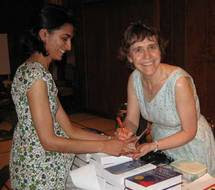Are you enamoured / enamored of something?
Enamoured / enamored by something?
Enamoured / enamored with something?
How about enamoured / enamored on something?
What preposition is correct after "enamoured / enamored"?
I know, you thought, "Well, definitely NOT "on"!" You may be surprised to learn that for the first three centuries or so after we borrowed this word from French, we English speakers were enamoured on people. Then, starting in about 1600, we became enamoured of people, and also of things.
A much less frequent possibility was "enamoured with", so infrequent that the OED editors in 1891 declared it obsolete, although it wasn't. "Enamoured with" burbled along for a couple of centuries, but then starting in the 1970s, began to stage a come-from-behind win on "of". (Keep scrolling after the chart, there's more.)
In the NOW corpus (6 billion words of online newspaper and magazine text starting in 2010), "enamo(u)red with" (1973 instances when I did the search) has pulled clearly ahead of "enamo(u)red of" (1065 instances). This is confirmed by the Canadian Newsstream database of Canadian newspapers (2425 with vs 1166 of since 2010). Indeed, the late nineties seem to have been decisive in the onward march of with as you can see from this chart of yearly usages of "enamo(u)red with" in Canadian Newsstream starting in 1991.
We're not done yet with this preposition competition. Lurking on the horizon is "enamo(u)red by": 1289 instances on NOW, notably more than "enamo(u)red of", and 509 on Canadian Newsstream.
The Canadian Oxford Dictionary offers only "of" but if I were revising it today I would change that. Personally, I say "enamoured of" and there is certainly nothing wrong with that, but as time marches on I will probably start to sound like an old fogey. What am I saying, I probably already sound like an old fogey to Young People Today. At least I don't say "enamoured on"!
For another prepositional shift, and more evidence of the arbitrariness of prepositions, see This is exciting.
I will be offering my fun "Rollicking Story of English" course in downtown Toronto again this fall. Subscribe to Wordlady to make sure you can be first to sign up when I open registration in a couple of weeks.
To have fun facts about English delivered right to your inbox, click here to subscribe by email.
Privacy policy: we will not sell, rent, or give your name or address to anyone. You can unsubscribe at any point.




